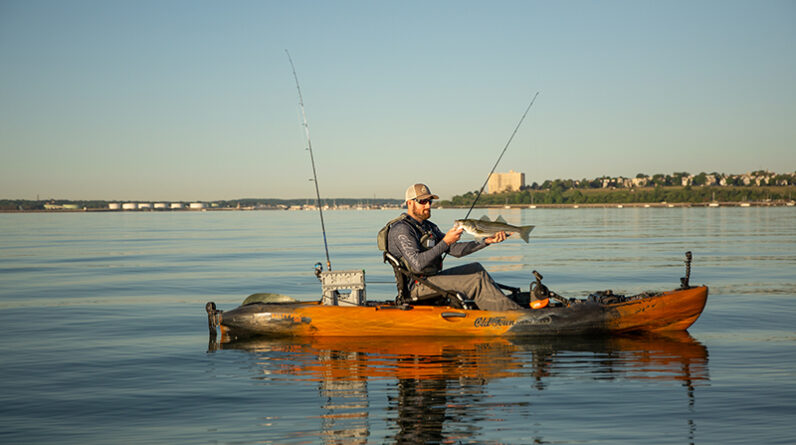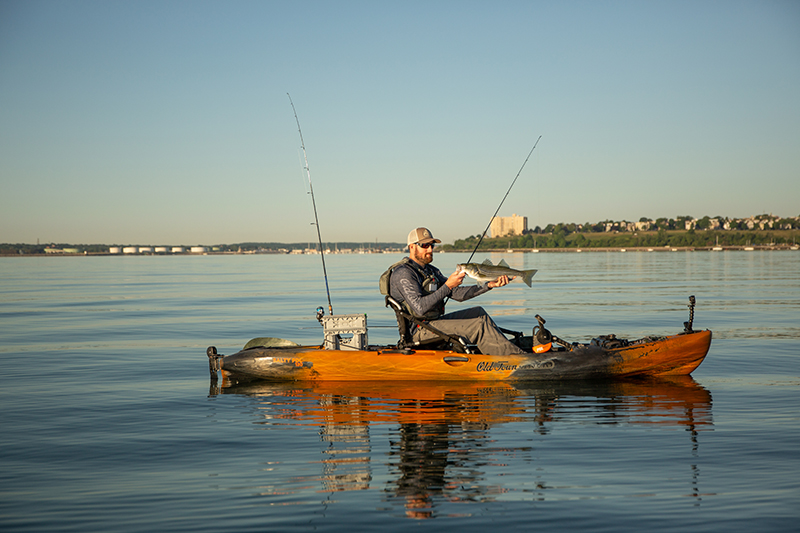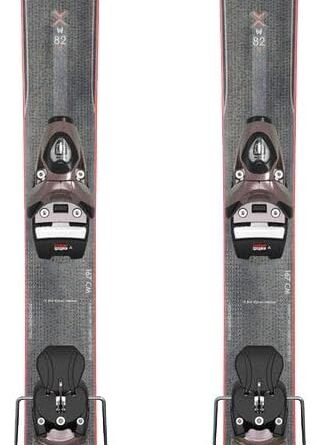
Are you a beginner interested in trying out saltwater kayak fishing? If so, you may be wondering how to choose the right fishing tackle for this exciting adventure. In this beginner’s guide, we will walk you through the different types of fishing tackle available and help you understand which ones are best suited for saltwater kayak fishing. Whether you’re targeting big game fish or simply seeking a relaxing day on the water, having the right fishing tackle can make a world of difference. So grab your paddle and join us as we dive into the world of saltwater kayak fishing and tackle selection.

This image is property of oldtownwatercraft.johnsonoutdoors.com.
Choosing the Right Fishing Rod
When it comes to choosing the right fishing rod for saltwater kayak fishing, there are a few factors you need to consider. The first thing to think about is the length of the rod. Generally, longer rods provide more casting distance, while shorter rods offer better control in tight spaces. Consider the type of fishing you’ll be doing and where you’ll be kayaking to determine the optimal length for your rod.
Next, you need to choose the right material for your fishing rod. Graphite and fiberglass are the two most common materials used in fishing rods. Graphite rods are lightweight and sensitive, making them ideal for kayaking. Fiberglass rods, on the other hand, are more durable and can withstand rougher conditions.
The power and action of a fishing rod also play a crucial role. Power refers to the rod’s ability to handle heavy loads, while action determines how the rod bends when pressure is applied. For saltwater kayak fishing, a medium to medium-heavy power rod with fast or medium-fast action is recommended as it offers a good balance between sensitivity and strength.
Considering the weight of the rod is also important. Since you’ll be maneuvering in a kayak, it’s essential to choose a lightweight rod that won’t strain your arms and shoulders. Additionally, a lighter rod will allow for better casting and control, especially when you’re fishing for long periods.
Lastly, think about your budget when choosing a fishing rod. Prices for rods can vary greatly depending on the brand, material, and quality. Set a budget that suits your needs and look for a rod that provides the best combination of features within your price range.
Selecting the Appropriate Fishing Reel
Choosing the right fishing reel is just as important as selecting the right rod. The type of reel you choose will depend on your personal preference and the fishing techniques you plan to use. The first step is to determine the reel type, which usually falls into four categories: spinning, baitcasting, spincasting, and fly reels.
For saltwater kayak fishing, spinning reels are a popular choice due to their versatility and ease of use. They are well-suited for casting lighter lures and can handle a wide range of fish species. Baitcasting reels offer more precision and control but have a steeper learning curve. Spincasting reels are beginner-friendly and feature a closed-face design, making them less prone to tangles. Fly reels are specifically designed for fly fishing and are not commonly used in kayak fishing.
Another factor to consider is the gear ratio of the reel. This ratio determines how many times the spool turns for each complete rotation of the handle. A higher gear ratio means faster line retrieval, which can be advantageous when kayak fishing as it allows you to quickly reel in your catch.
Choosing the right reel size is also crucial. Reel sizes are typically labeled numerically, with smaller numbers indicating smaller reels. Consider the type of fish you’ll be targeting and the line capacity you’ll need to determine the appropriate reel size for your needs.
The drag system of a reel is essential, especially when fighting larger saltwater species. Look for a reel with a smooth and reliable drag system that can handle the pressure of saltwater fishing.
As with the fishing rod, consider your budget when selecting a reel. Prices can vary greatly depending on the brand and features of the reel. It’s important to find a reel that is durable and performs well within your price range.
Understanding Fishing Lines
Choosing the right fishing line is often overlooked but plays a crucial role in your fishing success. There are several factors to consider when selecting a fishing line for saltwater kayak fishing.
The first consideration is the line type. The two most common types of fishing line are monofilament and braided lines. Monofilament lines are versatile, easy to handle, and have good knot strength. Braided lines offer superior strength, sensitivity, and abrasion resistance. They are ideal for saltwater kayak fishing as they can handle the rough conditions and provide better casting distance.
Line weight is another important factor to consider. The line weight should match the type of fish you’ll be targeting. Heavier lines are suitable for larger saltwater species, whereas lighter lines are better for smaller fish.
The strength of the fishing line is crucial when fishing in saltwater. Saltwater species tend to be stronger and more aggressive than their freshwater counterparts. Look for a fishing line with high tensile strength to handle the powerful runs and sudden bursts of saltwater fish.
Considering line visibility is also important, especially when fishing in clear or shallow waters. Transparent or low-visibility lines are less likely to spook fish, increasing your chances of a successful catch.
Lastly, think about the cost of the fishing line. Prices can vary depending on the brand, type, and quality of the line. Set a budget and find a line that meets your needs without breaking the bank.
Picking the Right Fishing Lures
Selecting the right fishing lures for saltwater kayak fishing can greatly increase your chances of success. There are various factors to consider when choosing fishing lures.
Firstly, consider the type of lure you’ll be using. There are countless lure types available, such as crankbaits, jigs, spoons, soft plastics, and topwater lures. Each lure type has its own unique action and is designed to attract specific fish species or mimic certain prey.
The size of the lure is also important. Smaller lures are generally more effective when targeting smaller fish species, while larger lures are more suitable for larger predatory fish. Consider the size of the baitfish or prey in the area you’ll be fishing and choose a lure size that closely matches it.
The weight of the lure affects its depth and casting distance. Lighter lures are more suitable for shallow waters, while heavier lures can reach deeper depths. Depending on the fishing conditions and the species you’re targeting, choose a lure weight that allows you to effectively present your bait in the desired zone.
Lure color can also make a difference in attracting fish. Some anglers believe that certain colors are more effective in specific water conditions or for certain fish species. Experiment with different colors and patterns to see which ones work best for you.
Consider the price of the lure when making your selection. Lure prices can vary greatly depending on the brand and quality. It’s important to find a lure that fits your budget and provides good value for money.

This image is property of www.lowrance.com.
Selecting the Proper Fishing Hooks
Choosing the right fishing hooks is crucial as they are responsible for hooking and securing your catch. Consider the following factors when selecting fishing hooks for saltwater kayak fishing.
Firstly, determine the hook type that suits your fishing needs. There are various hook types, including J-hooks, circle hooks, treble hooks, and single hooks. Each hook type has its own advantages and is suitable for different fishing techniques and fish species. Research the characteristics of each hook type to find the one that best suits your needs.
The hook size is also important. Hooks are sized numerically, with larger numbers indicating smaller hooks. Consider the size of the fish you’ll be targeting to determine the appropriate hook size. Remember that using a hook that is too large or too small can impact your hooking efficiency.
Hook shape plays a role in determining the hook’s effectiveness. Some common hook shapes include round bend, offset bend, and wide gap. Each shape has its own advantages and is suitable for different fishing situations. Experiment with different hook shapes to find the one that works best for you.
Hook strength is crucial when targeting saltwater species, as these fish can put up a strong fight. Look for hooks with high tensile strength and durability to ensure they can withstand the pressure.
Consider the price of the hooks when making your selection. Prices can vary depending on the brand and quality of the hooks. It’s important to find hooks that are reliable and within your budget.
Understanding Fishing Baits
Choosing the right bait is a vital aspect of saltwater kayak fishing, as it determines whether fish will be attracted to your line. Consider the following factors when selecting fishing baits.
Live baits are a popular choice among anglers as they can mimic the natural movement and scent of prey. Consider using live baits such as shrimp, mullet, or pilchards to attract a wide range of saltwater fish species.
Artificial baits, such as soft plastics or crankbaits, can also be effective in saltwater kayak fishing. These baits come in various colors, shapes, and sizes and can imitate different prey species. Experiment with different artificial baits to find the ones that produce the best results.
Cut baits are another option to consider. They involve using pieces of fish, squid, or other baitfish to attract saltwater species. Cut baits can be effective for larger predatory fish that feed on chunks of prey.
Before using any bait, it’s important to consider the legality of the bait for the area you’ll be fishing. Some areas have restrictions on certain bait types to protect the local ecosystems.
Consider the price of the bait when making your selection. Live baits are typically more expensive than artificial or cut baits. Determine your budget and choose baits that suit your needs without breaking the bank.

This image is property of thefishingadvice.com.
Determining the Right Fishing Lines to Use
When choosing fishing lines for saltwater kayak fishing, several factors come into play. Consider the following factors to determine the right fishing lines to use.
Firstly, consider the fishing conditions. If you’ll be fishing in rough conditions with strong currents or sharp structures, opt for a fishing line with higher abrasion resistance. This will help prevent break-offs and increase the longevity of your line.
The target species also play a role in determining the fishing line to use. Larger saltwater species require stronger lines with higher breaking strength to handle their powerful runs. Smaller species can be targeted with lighter lines for a more finesse approach.
The fishing technique you’ll be using is another important factor. Different techniques, such as trolling, casting, or bottom fishing, require different line lengths and strengths. Tailor your fishing line to match the technique you’ll be employing.
Consider the length of the fishing line. Longer lines are beneficial when casting further distances or when targeting species that require greater depth. Shorter lines offer better control and accuracy in tight spaces.
Lastly, think about the cost of the fishing line. Prices can vary greatly depending on the brand, type, and quality of the line. Set a budget and find a fishing line that meets your needs without exceeding your financial limits.
Deciding on the Type of Fishing Reels
When it comes to choosing the type of fishing reel for saltwater kayak fishing, there are several options to consider. Each reel type has its own advantages and is suitable for different fishing techniques and preferences.
Spinning reels are the most versatile and popular choice for kayak fishing. They are easy to use, offer good line capacity, and are suitable for a wide range of fish species. Spinning reels are especially useful for casting lighter lures and can handle both freshwater and saltwater conditions.
Baitcasting reels are favored by experienced anglers due to their precision and control. They offer excellent casting distance and accuracy, making them ideal for targeting larger saltwater species. Baitcaster reels have a steeper learning curve, but with practice, they can be a valuable asset for kayak fishing.
Spincasting reels, also known as closed-face reels, are beginner-friendly and popular among casual anglers. They feature a cover that prevents tangles, making them easy to use and maintain. Spincasting reels are a great choice for beginners or for those who prefer simplicity and convenience.
Fly reels are specifically designed for fly fishing and are less commonly used in kayak fishing. They are lightweight and offer greater control over the fly line. If you plan to pursue fly fishing from your kayak, consider investing in a fly reel that matches your needs.
Electric reels are a specialized type of reel that is typically used for deep-sea fishing or targeting large game fish. They feature an electric motor that assists in reeling in heavy catches. Electric reels are not commonly used in kayak fishing due to their increased weight and power requirements.
Consider your fishing needs, preferences, and budget when deciding on the type of fishing reel for saltwater kayak fishing. Each reel type has its own advantages and drawbacks, so choose the one that best suits your style of fishing.
This image is property of captain-uploads.s3.us-east-2.amazonaws.com.
Choosing the Appropriate Fishing Rods
Choosing the right fishing rod for saltwater kayak fishing is essential for an enjoyable and successful fishing experience. There are various types of fishing rods available, each designed for specific fishing techniques and environments.
Spinning rods are the most common choice for kayak fishing due to their versatility and ease of use. They can handle a wide range of fish species and offer good casting distance and accuracy. Spinning rods are suitable for both freshwater and saltwater conditions.
Casting rods, also known as baitcasting rods, are favored by experienced anglers and those targeting larger saltwater species. They offer increased power and control, allowing for precise bait placement and longer casts. Casting rods require more skill to use effectively, but they provide excellent sensitivity and can handle heavy line and lures.
Surf rods are designed specifically for surf fishing and can be used effectively from a kayak. They are longer and heavier than conventional fishing rods, allowing for longer casting distances. Surf rods are ideal for targeting larger saltwater species from a kayak.
Fly rods are designed for fly fishing and are not commonly used in kayak fishing. They are longer and more flexible than other rods, allowing for delicate presentations of fly lures. If you plan to pursue fly fishing from your kayak, consider investing in a fly rod that matches your needs.
Telescopic rods, also known as collapsible rods, are a great option for kayak fishing due to their portability. They can be easily transported and stored, making them convenient for kayak anglers. Telescopic rods come in various lengths and power ratings, so choose one that suits your fishing needs.
Consider your fishing style, target species, and budget when choosing the appropriate fishing rod. Each rod type offers its own advantages and is designed for specific fishing situations, so select the one that best aligns with your preferences.
Understanding Fishing Tackle Terminology
Understanding fishing tackle terminology is essential for selecting the right equipment for saltwater kayak fishing. Familiarize yourself with the following terms to make informed decisions when purchasing fishing tackle.
Rod power refers to the amount of force required to bend or flex a fishing rod. It is typically categorized as ultralight, light, medium, medium-heavy, or heavy. The power of the rod determines its ability to handle different fish species and fishing techniques.
Rod action describes the point of the rod where it flexes when pressure is applied. It can range from slow to fast, with medium-fast being the most commonly used for kayak fishing. Action affects casting distance, sensitivity, and your ability to control the fish.
Reel gear ratio indicates how many times the spool rotates for each complete turn of the handle. A higher gear ratio means faster line retrieval, which can be advantageous when kayak fishing to quickly reel in your catch.
Reel size refers to the physical size of the fishing reel. It is typically indicated as a numerical value, with smaller numbers indicating smaller reels. The reel size should match the rod and the target species to ensure optimal performance.
Line breaking strength, also known as pound test, refers to the maximum weight the fishing line can handle before it breaks. It is an important factor to consider when targeting larger saltwater species that require stronger lines.
Understanding these fishing tackle terminologies will help you make informed decisions when selecting the right equipment for saltwater kayak fishing. Consider the specific requirements of your fishing style, target species, and fishing conditions to choose the tackle that best suits your needs.

This image is property of www.kayaks2fish.com.







